Data center cyclopic sizes and Tier IV, how can this be? Meet - SuperNAP 8
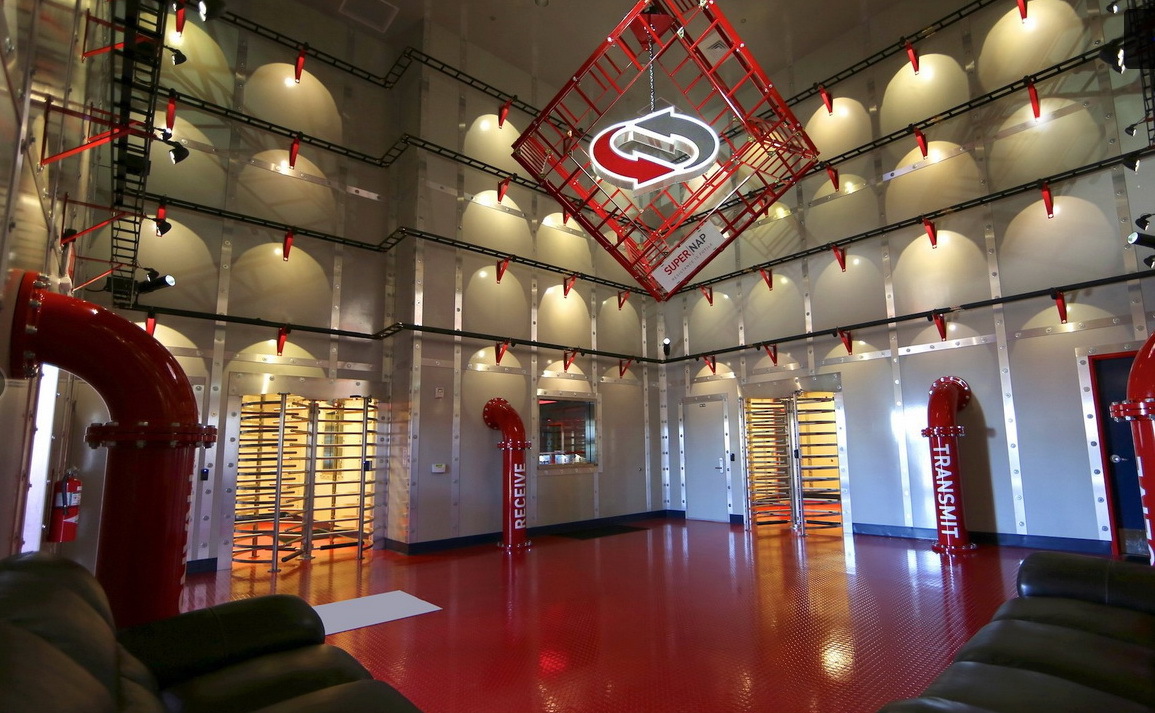
The debut of the SuperNAP data center in 2009 brought Switch to the new horizons of its development. SuperNAP, spread over more than 37,000 square meters in Las Vegas, Nevada, provided an unprecedented opportunity to place a huge number of server racks in a single place. The construction of the DC housed servers and storages of many leading IT companies, including more than 40 cloud service providers, and also united many trunk providers under one roof.
After you have created a huge SuperNAP, what will be your next step? If you are a Switch company, one of the leaders of the DC construction market, then right there, behind its fence, you will be engaged in the construction of an even more powerful SuperNAP.
')

The newest creation of the company, known as SuperNAP 8, was built on the basis of a number of innovations both in cooling technology and ensuring reliability. The construction of DC was the first platform accessible to many users, where in practice the principles of building DC reliability were implemented at the level of Tier IV - the maximum possible rating from the Uptime Institute, which characterizes resistance to the occurrence of possible “falls” in DC.
According to the founder and CEO of Switch Rob Roy, SuperNAP was the culmination of a ten-year period of thought development, rethinking the principles of building data centers. The SuperNAP design allows it to function efficiently anywhere in the world, in any climatic zone, which allows it to become a model, a prototype of the DC, on the basis of which the company will grow throughout the world. Switch is finalizing its plans for international expansion and is preparing to announce them a bit later this year.
“We focused all our efforts on creating the best data center in the world,” said Roy, who patented many design innovations for the Switch company during the project development process. “SuperNAP is the crown of all our efforts. I wanted to see if we can create a single global standard for all future DCs ”

The first platform for the collocation of Tier IV
The efforts that have been made by the data center designers have made an indelible impression on the staff of the Uptime Institute, whose work consists in conducting a DC safety assessment around the world according to its own certification program. Only four of the DCs ever built in the United States received a Tier IV security certificate, the highest existing one. Until now, DCs of this level of security were only in the closed, sole use of various kinds of large financial institutions, without the possibility of free placement of equipment from other customers.
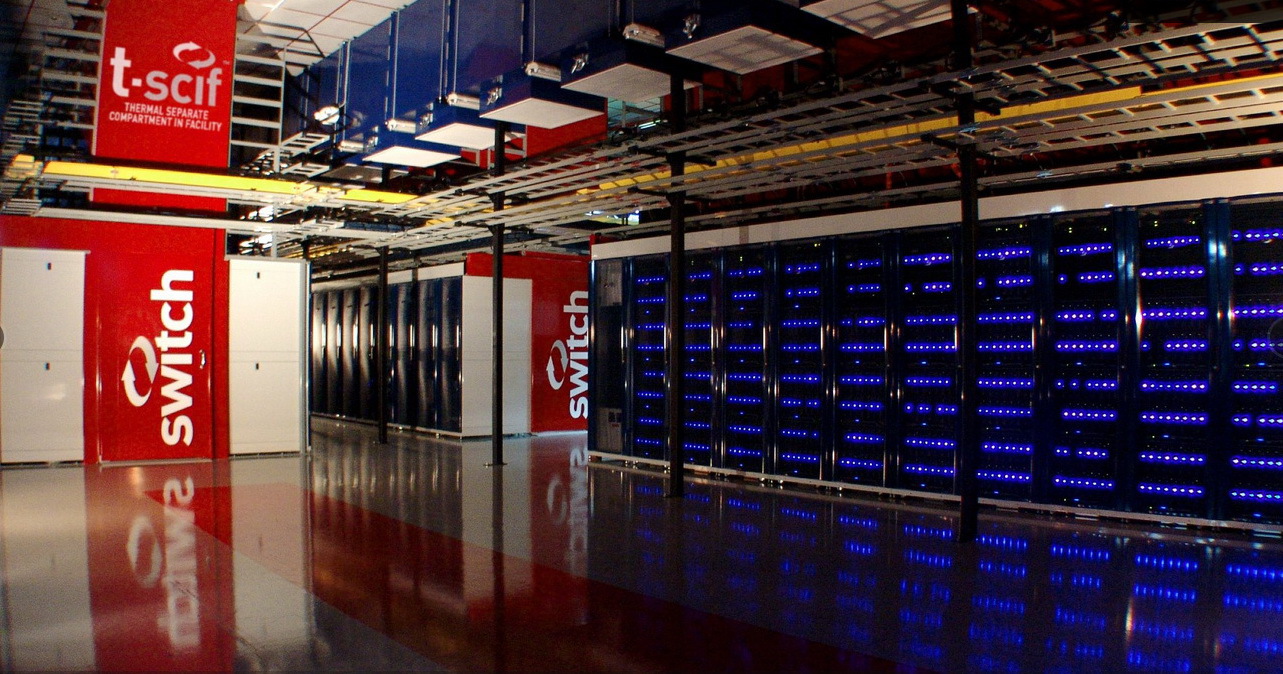
“For the first time, a Tier IV certificate was assigned to a data center with a flexible client access model, which already speaks for itself. This is the way to the next stage of development of this sector of the IT industry, ”said Ed Raffer, vice president of technology at the Uptime Institute. “Switch SuperNAP 8 has gathered a large number of well-designed innovative solutions to meet all the requirements for infrastructure operation.”
Located in Las Vegas, SuperNAP 8 is the next step in Roy’s vision of what a city’s technology system should be. Currently, this Switch site is serviced by about 315 highly qualified employees, with more than 1000 clients located on it. In addition, the company provides work for more than 1000 engineers and workers involved in the company's projects. The SuperNAP 8 premises of almost 28 thousand square meters are located just a few hundred meters from the original SuperNAP (now known as SuperNAP 7).
SuperNAP 8 was built using ready-made modules made directly by the Switch itself. The key element, known as MacroMOD, includes two server rooms. Switch plans to place its customers in these two halls, which in turn occupy only half of the space of the new building.
So what makes SuperNAP 8 so qualitative? The data center combines a combination of concentration and efficiency, similar to that achieved in SuperNAP 7, which works year-round with PUE (Power Usage Efficiency) at the 1.18 level. This ratio is only slightly behind the existing DCs of Google Corporation, which has a number of sites with an average annual PUE of 1.12.
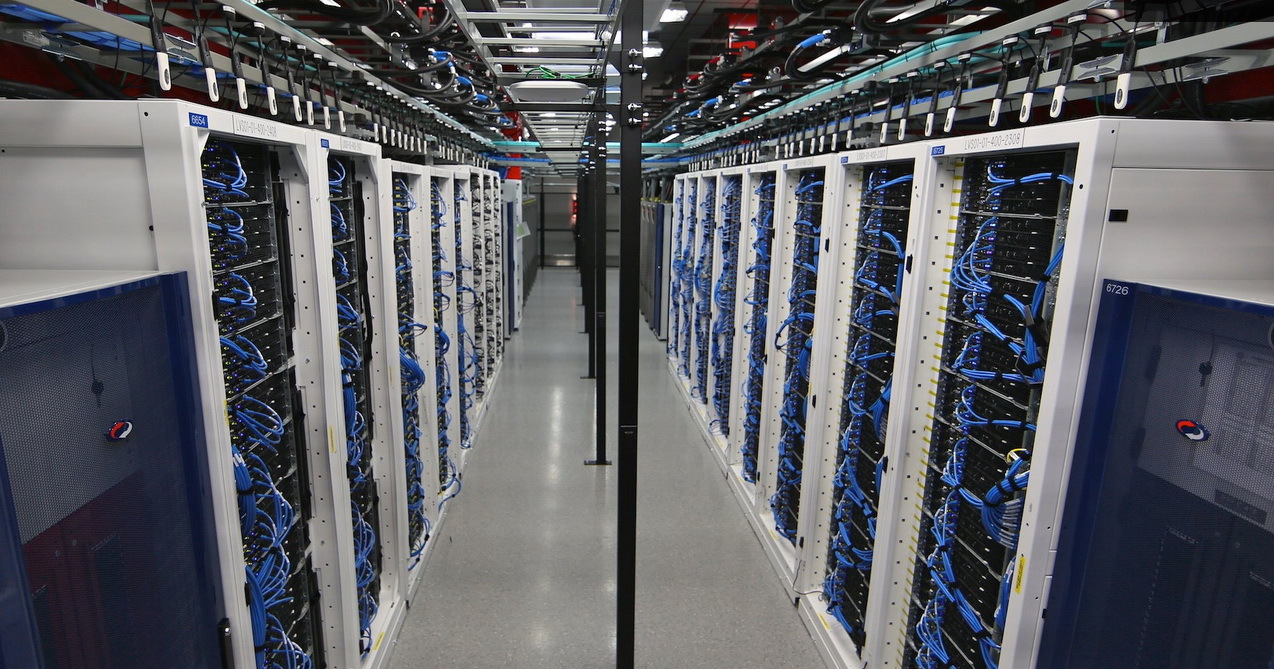
This level of efficiency is unique to a multi-user site, since its temperature requirements are more stringent. Switch has to maintain the temperature in the server rooms no more than 20 degrees Celsius with 40% humidity, while large players like Google and Facebook can afford a temperature ceiling of 26-27 degrees in their data center of a similar class.

Innovations of a high level are noticeable in design, in how exactly DC is organized. In SuperNAP 7, massive overpasses carry the power cables that go down to the center of the building, where they branch and diverge into the server rooms and switchboard rooms spaced apart on opposite sides of the building. In SuperNAP 8, all the rooms with power equipment are assembled side by side and placed on one side of the structure, while the racks with power cables are located in a row on the other side.
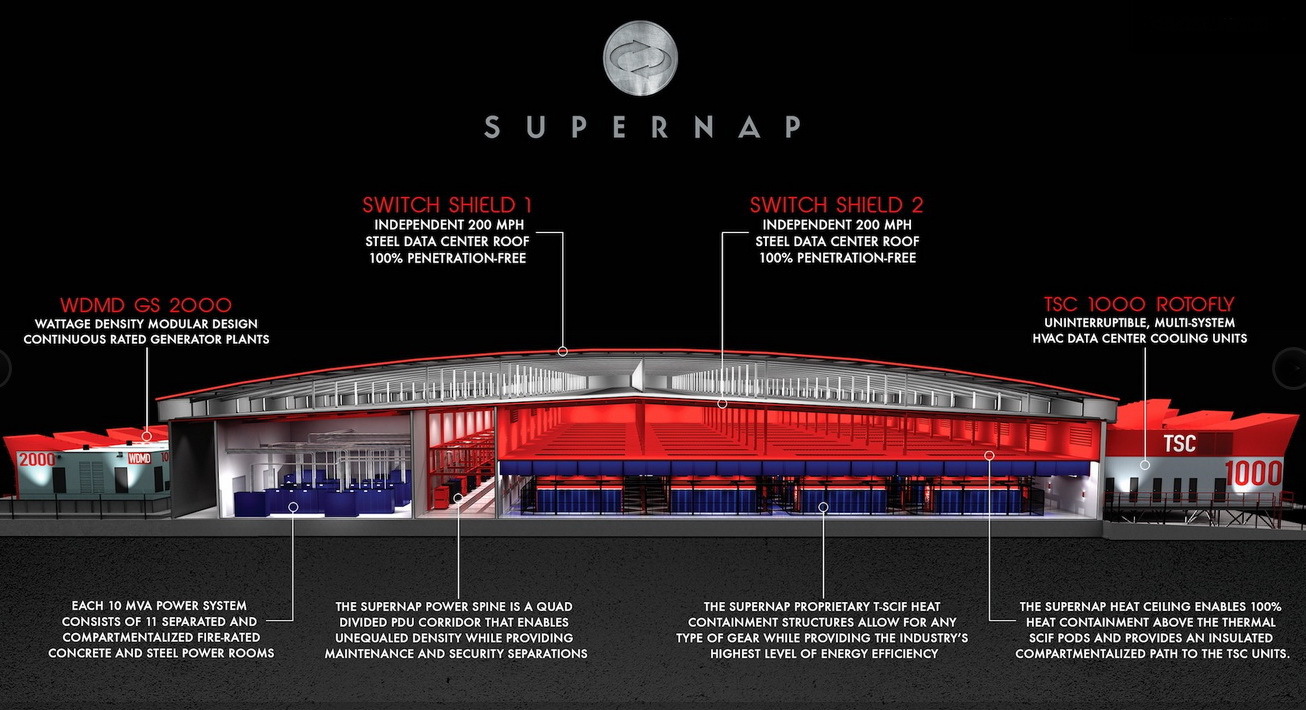
The remaining internal space, facilities, reserved for server rooms, the elements of the cooling system remained outside the internal space, located along one of the sides of the DC. In the above image, you can see a section cut of the building structure, which shows the placement (from left to right) of the generator, switchboard room, power line, server room, and cooling units.
SuperNAP 8 is also qualitatively distinguished from its predecessor cooling units of gigantic sizes, each of which can supply up to 1000 tons of prepared air (for example, the cooling unit on the SuperNAP 7 could supply no more than 600 tons). The units, like the old ones, have an elongated shape, which allows them all to easily fit on one side of the DC building, but the design feature of the units is an additional air intake on the upper part of the structure. Also, its positive role is played by an advanced system of separation of hot and cold air channels.
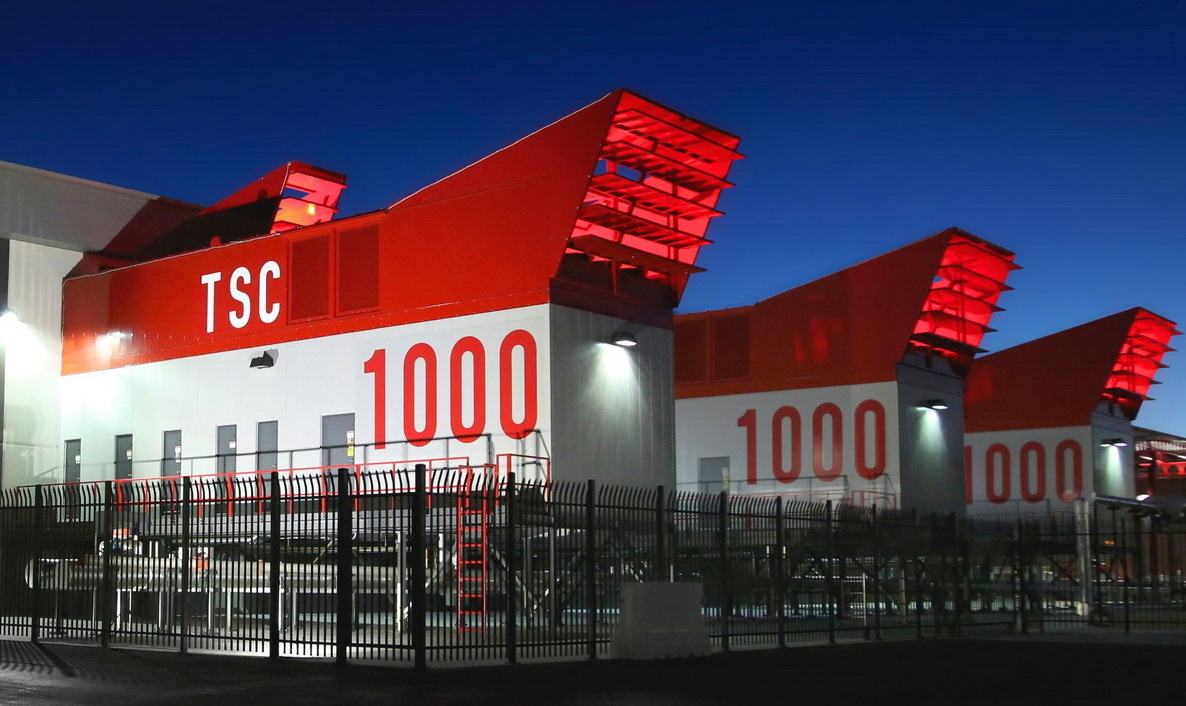
By themselves, the cooling units that are attached to the outer wall of the DC are surprisingly versatile, they support six different cooling modes. The software of the units allows you to automatically assign the most appropriate mode of operation at a particular moment, based on an analysis of the indoor temperature, as well as several other parameters. These new cooling units, which have decorated SuperNAP 8, are designed so that they completely reflect the Switch ambitions of entering new markets that are located in different geographic latitudes. Specially designed hoods ensure efficient operation of cooling units even with accumulations of snow and ice, and the air that comes from the hot aisles prevents them from accumulating in large quantities. The unique constructive solution allows you to respond to those challenges for air conditioning systems that are inevitable when operating in cold climates.
Flywheels increase cooling system capacity.
The innovative system of corrugated surfaces used in SuperNAP 8 using rotary flywheels weighing almost one tonne each in cooling units can efficiently cool the server rooms even in the event of a power failure in the cooling system.
Also, the design innovations related to cooling affected the interior of the DC itself. One of these innovations is sprawling steel racks, known as the "Black Forest of Steel." Steel plays a dual role here: it provides physical support for the Switch’s developed equipment placement system, known as T-SCIF, and also helps cool the DC room, acting as a kind of radiator that is cooled by circulating air, which could be an additional temperature “airbag” in case of failures in cooling.
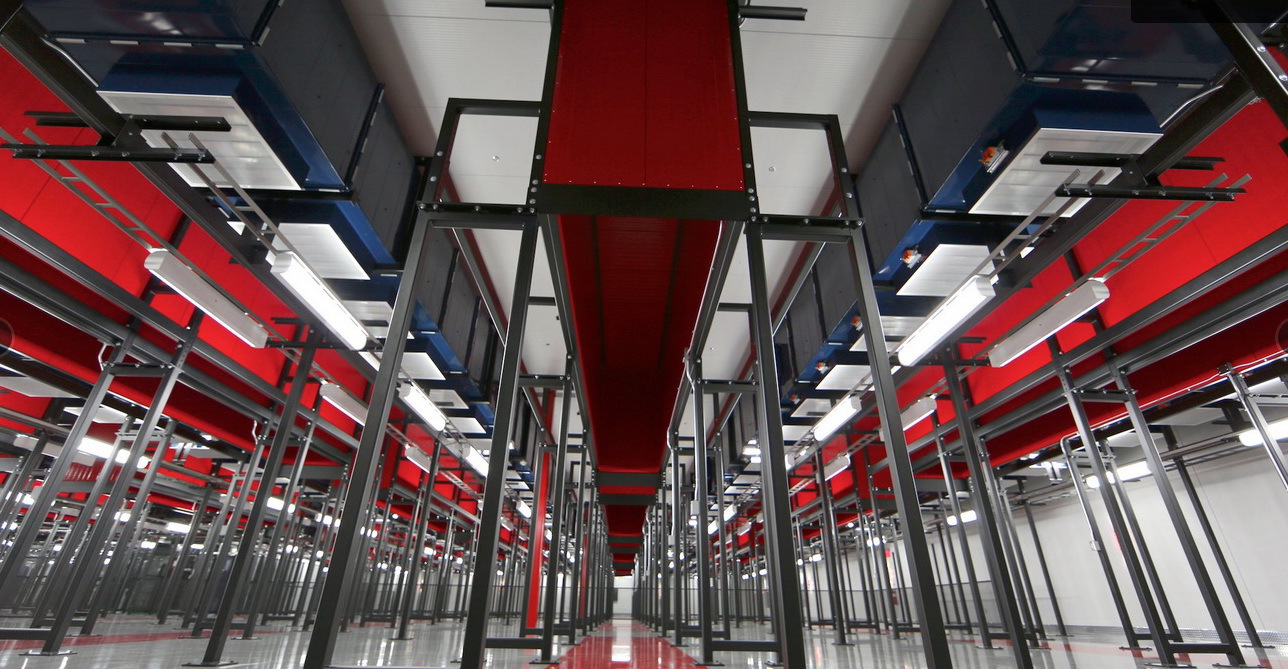
“When the temperature rises to 20 degrees, the steel heats up to 20 degrees,” says Roy. “These racks, like radiators, give off heat extremely efficiently. They are designed more massive specifically so that they can absorb more heat. As a result of high recoil heat from steel, the overall temperature in the room is somewhat reduced. "
Innovative Solution - SwitchSHIELD
The roof is usually not one of the special features or benefits of the data center. But Roy argues that it is the construction of the roof that plays a very important role in the life cycle of any DC. “99% of existing DCs will be forced to replace the roof during the DC’s life cycle, and in these very moments DCs become extremely vulnerable,” Roy said.
It is for this reason that SuperNAP 8 has a unique SwitchSHIELD, a double roof system that can withstand wind outside the building at a speed of 90 m / s. Two independent horizons of overlap are placed one from another at a distance of 2.7 meters and are attached directly to the concrete and metal structures of the structure, while not intersecting with each other. This decision allowed Switch to replace the roof without the slightest risk to the security of the servers beneath.
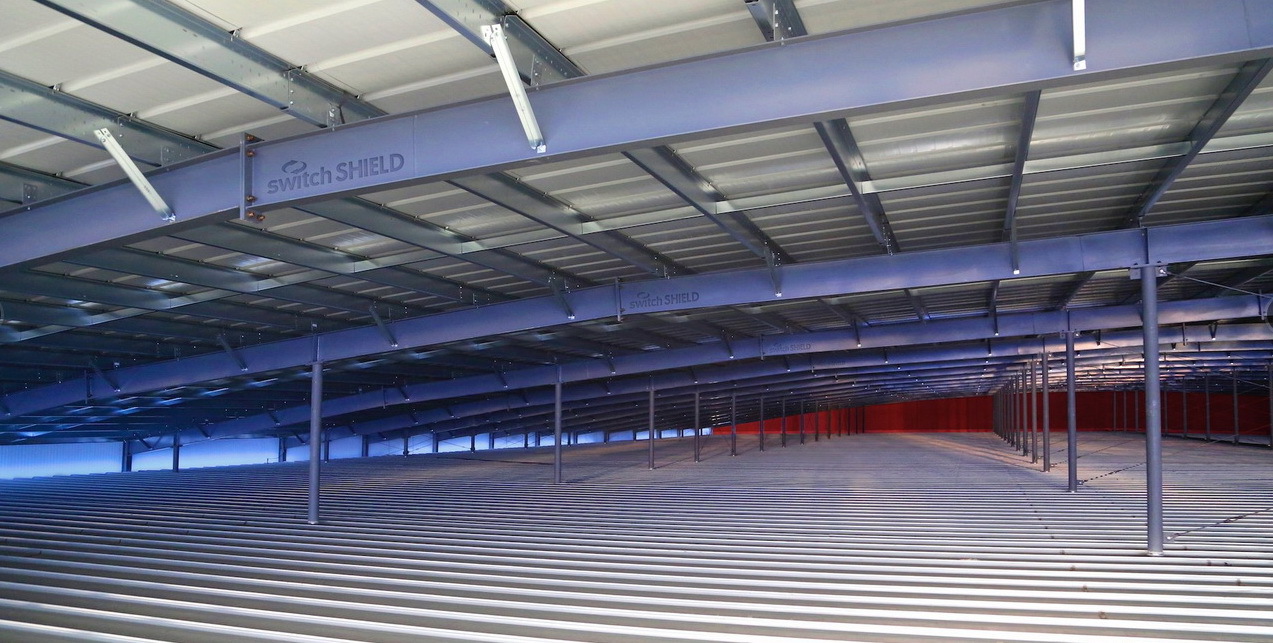
The unique SwitchSHIELD is a feature that is another application for the company's expansion into the international market, with the ability to offer this product in various climatic zones. Tornadoes in the state of Nevada are extremely rare, and the region has never been famous for record winds that could be countered with such a serious defense. Double roofing will be a more significant positive difference in the markets of countries and territories, which often suffer from the destructive force of hurricanes and tornadoes.
Only forward, not a step back
“Rob Roy set the standards bar for our industry,” said Missy Yong, executive vice president of Switch. “With his vision of the future of the industry, Switch SuperNAP will continue to change the world of data centers, technological advances in the industry will make it possible for ordinary businesses to place their data in the highly secure SuperNAP ecosystem.”

“The quality of the services we provide is so high that there has never been a precedent for serious downtime for which we would have to compensate,” said Yong. “We have no plans to slow growth. Our main task has always been to meet the rapidly growing market demands. ”
And indeed, not far from the standing SuperNAP 8 team of builders are already beginning work on the construction of SuperNAP 9, which should become the largest among the existing Switch projects. Its total area should be 55 thousand square meters, according to preliminary data, it should be put into operation in the first half of 2015.
Source: https://habr.com/ru/post/227265/
All Articles